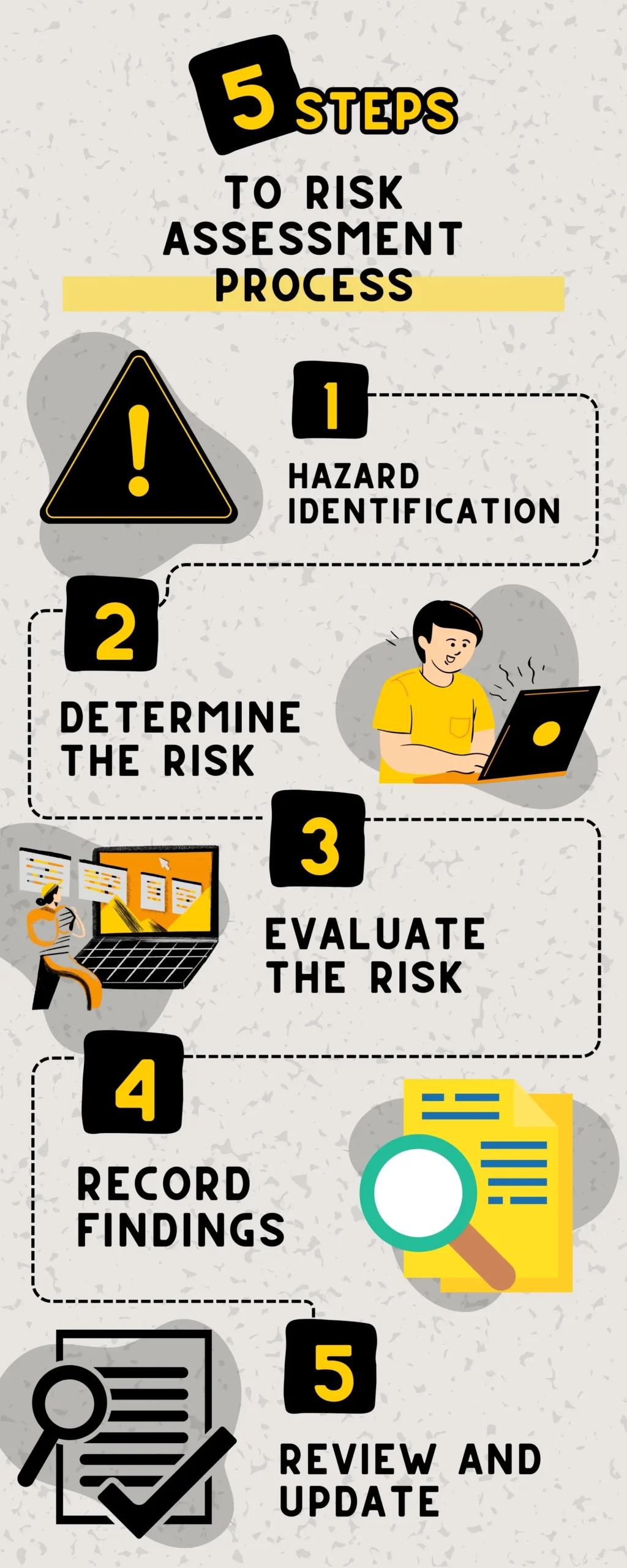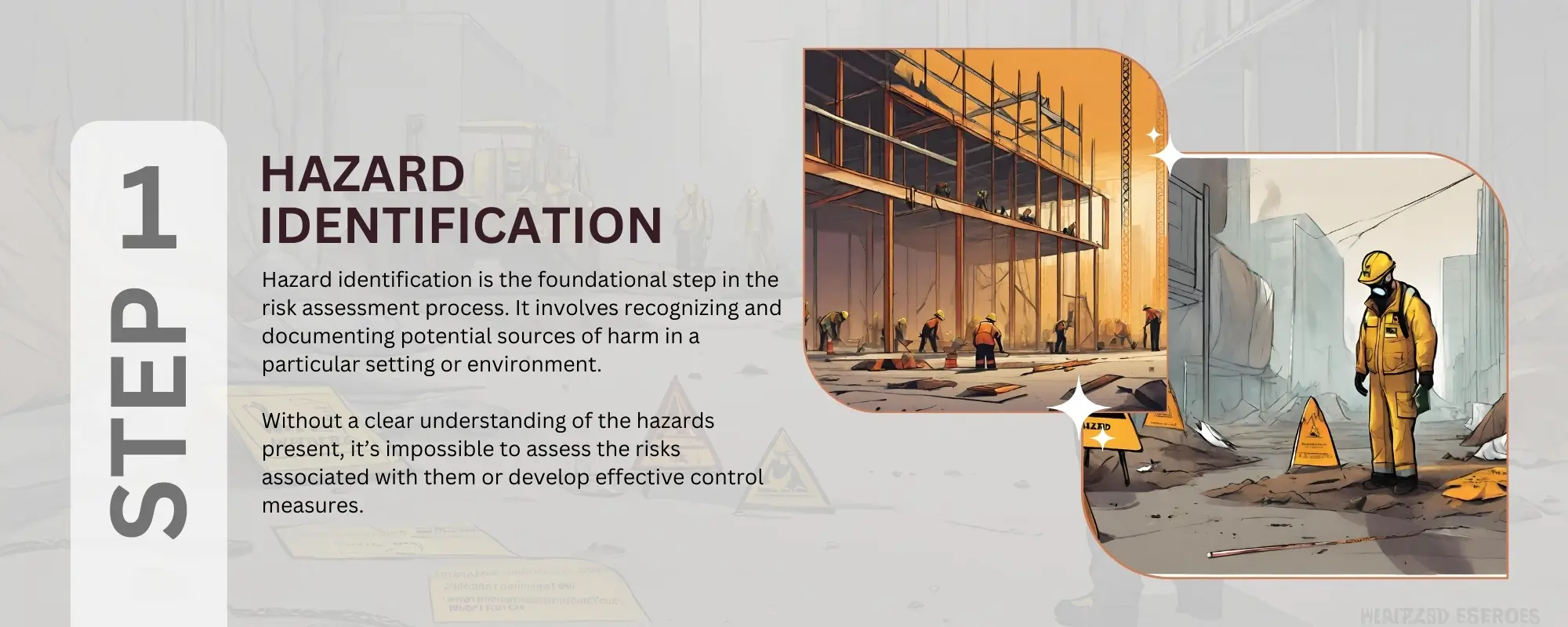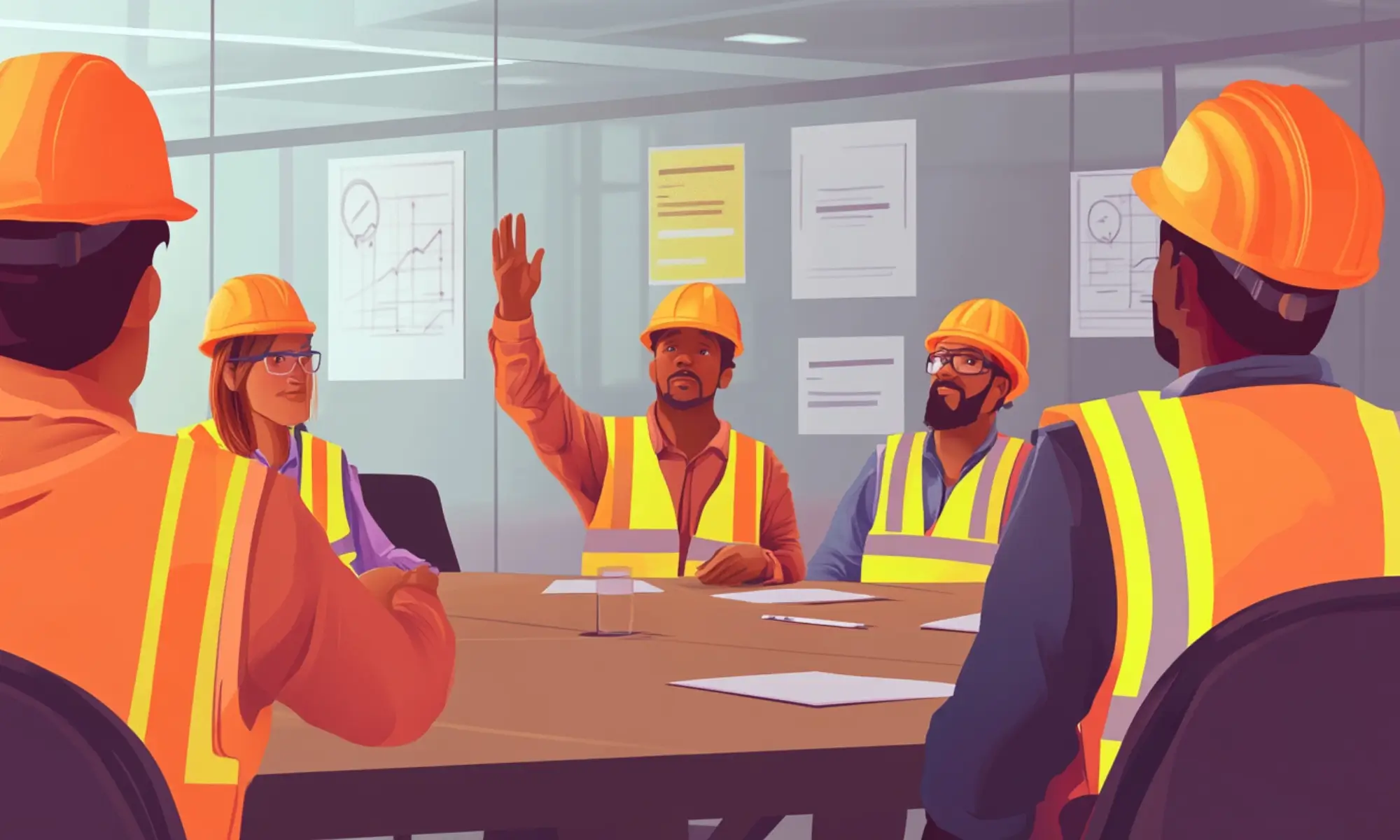Understanding the risk assessment process is crucial for maintaining a safe and compliant work environment. This step-by-step guide for 2025 will walk you through the five essential steps of conducting a thorough risk assessment. By identifying potential hazards, evaluating the associated risks, and implementing effective control measures, you can ensure the well-being of your organization and its people. This guide aims to make the process clear and manageable, providing you with the knowledge and confidence to protect your operations and meet regulatory requirements.
What is Risk Assessment?
Risk assessment is a systematic process of identifying, analyzing, and evaluating potential risks that could negatively impact an organization’s operations, assets, or individuals. By thoroughly analyzing these risks, companies can develop strategies to mitigate or eliminate them, ensuring a safe and compliant work environment.
Conducting a risk assessment is essential for maintaining safety and security, showing a commitment to excellence and protecting everyone involved. It is not only a best practice but also a regulatory requirement in many industries, helping organizations prevent incidents and ensure compliance with safety standards. While it may seem daunting, support and resources are available to help you every step of the way, contributing to a safer and more productive environment.
The 5 Steps to Conducting a Risk Assessment
The risk assessment process can be broken down into five essential steps:
- Hazard Identification: Identify potential hazards present in the environment.
- Determine the Risk: Using qualitative and quantitative analysis, assess risks associated with each identified hazard.
- Evaluate the Risk: Weigh up whether you’ve taken enough precautions or if more should be done to prevent harm.
- Record Findings: Document the hazards, associated risks, and measures taken to control them.
- Review and Update: Regularly review the risk assessment to ensure it remains relevant and effective.


Step 1: Hazard Identification
Hazard identification is the foundational step in the risk assessment process. It involves recognizing and documenting potential sources of harm in a particular setting or environment. Without a clear understanding of the hazards present, it’s impossible to assess the risks associated with them or develop effective control measures.
Here’s a more detailed breakdown of this crucial step:
1. Definition of a Hazard
A hazard is any source of potential damage, harm, or adverse health effects on something or someone. Essentially, it’s anything that can cause harm. Hazards can be physical (e.g., machinery), chemical (e.g., toxic substances), biological (e.g., bacteria or viruses), ergonomic (e.g., poor posture), or even psychosocial (e.g., workplace stress).
2. Sources of Information for Hazard Identification
- Workplace Inspections: Regular walkthroughs of the work environment can help spot potential hazards. This includes observing processes, reviewing equipment, and noting any irregularities.
- Employee Feedback: Workers often have firsthand knowledge of the hazards in their jobs. Engaging them can provide valuable insights.
- Incident and Accident Reports: Past incidents can offer clues about existing hazards. Reviewing these reports can help in identifying patterns or recurring issues.
- Material Safety Data Sheets (MSDS): These provide information on chemical products, detailing their hazards, handling procedures, and safety precautions.
3. Categorizing Hazards
Once identified, hazards can be categorized based on their nature. For instance:
- Physical Hazards: Include machinery, electrical equipment, or anything that can cause physical injury.
- Chemical Hazards: Relate to substances that can cause harm when inhaled, ingested, or come into contact with the skin.
- Biological Hazards: These include bacteria, viruses, and other microorganisms that can cause diseases.
4. Documenting the Hazards
It’s essential to maintain a record of all identified hazards. This documentation should include:
- Description of the hazard.
- Location of the hazard.
- Potential outcomes if the hazard leads to an incident.
- Any existing control measures.
5. Prioritizing Hazards
Not all hazards pose the same level of threat. Some might have the potential to cause severe harm but have a low likelihood of occurring, while others might be more probable but less harmful. Prioritizing helps in determining which hazards need immediate attention.
6. Continuous Monitoring
Hazard identification isn’t a one-time activity. As work environments change, new hazards may emerge. Continuous monitoring ensures that new or evolving hazards are promptly identified and addressed.
In conclusion, hazard identification is a proactive approach to safety. By identifying potential hazards early, organizations can take steps to protect their employees and reduce the likelihood of adverse events.

Step 2: Determine the Risk
Once hazards have been identified, the next step is to determine the risk associated with each hazard. Risk determination involves evaluating the likelihood of the hazard causing harm and the severity of that harm.
This step is crucial as it helps prioritize which hazards need immediate attention and which control measures to implement. Here’s a detailed breakdown of this step:
1. Definition of Risk
Risk is defined as the combination of the likelihood of an occurrence of a hazardous event and the severity of injury or damage caused by this event. In simpler terms, it’s the potential consequence of a hazard combined with how likely it is to occur.
2. Qualitative Analysis
Qualitative risk analysis involves assessing risk based on non-numeric categories or levels. It’s more subjective and often uses terms such as “low,” “medium,” or “high” to describe the level of risk. The process might involve:
- Expert Judgement: Relying on the experience and knowledge of experts to assess risk.
- Checklists: Using predefined lists to ensure all potential risks are considered.
- Brainstorming: Engaging a team to discuss and identify potential risks.
3. Quantitative Analysis
Quantitative risk analysis, on the other hand, involves numerical values. It provides a more objective and precise evaluation of risk. Methods might include:
- Probability Analysis: Determining the likelihood of a particular event occurring.
- Loss Estimation: Estimating the potential consequences or impact of an event.
- Statistical Analysis: Using historical data to predict future risks.
4. Risk Matrix
A common tool used in risk determination is the risk matrix. It’s a grid that plots the likelihood of an event occurring against its potential severity. Each intersection on the matrix represents a risk level, helping organizations prioritize their response.
5. Factors to Consider
When determining risk, several factors should be considered:
- Frequency of Exposure: How often are workers exposed to the hazard?
- Duration of Exposure: How long are workers exposed to the hazard?
- Potential Severity: What’s the worst possible outcome if the hazard leads to an incident?
- Existing Control Measures: Are there any measures already in place to mitigate the risk?
6. Documenting the Risk
Similar to hazard identification, it’s essential to document the determined risks. This documentation should include:
- The identified hazard.
- The likelihood of occurrence.
- The potential severity.
- The overall risk rating (e.g., low, medium, high).
7. Review and Update
As with hazard identification, risk determination is not static. As conditions change, previously assessed risks might increase or decrease. Regular reviews ensure that risk assessments remain accurate and relevant.
In conclusion, determining the risk is a systematic approach to understanding the potential impact of identified hazards. By assessing risks qualitatively and quantitatively, organizations can make informed decisions about where to focus their risk management efforts.

Step 3: Evaluate the Risk
Risk evaluation is the process of comparing the determined risk against predetermined standards or risk criteria to decide whether the risk is acceptable or if further control measures are required.
This step is pivotal as it helps organizations prioritize their resources and efforts in managing risks. Here’s a detailed exploration of this step:
1. Definition of Risk Evaluation
Risk evaluation involves making decisions about the significance of the identified and assessed risks. It’s about deciding which risks are significant and must be managed immediately and which ones can be accepted or deferred for treatment at a later time.
2. Establishing Risk Criteria
Before evaluating risks, organizations need to establish risk criteria. These criteria define what is considered an acceptable or tolerable level of risk. Factors to consider might include:
- Legal and regulatory requirements.
- Organizational objectives and policies.
- Stakeholder concerns and expectations.
- Industry best practices.
3. Comparing Assessed Risk to Criteria
Once the risk criteria are set, the next step is to compare the determined risks (from Step 2) against these criteria. This comparison will help in deciding the following:
- Which risks are acceptable and don’t need further action?
- Which risks exceed the acceptable level and need further control measures.
4. Prioritizing Risks for Treatment
Not all risks that exceed the acceptable level will be treated immediately. Some might be more critical than others. During risk evaluation, risks are often prioritized based on factors like:
- Severity of potential consequences.
- Likelihood of occurrence.
- Public perception and stakeholder concerns.
- Cost and feasibility of implementing controls.
5. Documenting the Evaluation
It’s crucial to maintain a record of the risk evaluation process. This documentation should include:
- The assessed risk level.
- The predetermined risk criteria.
- Decisions are made about the acceptability of the risk.
- Any prioritization of risks for treatment.
6. Engaging Stakeholders
Risk evaluation often involves engaging various stakeholders, including employees, management, regulatory bodies, and even the public in some cases. Their input can provide different perspectives and insights, ensuring a comprehensive evaluation.
7. Continuous Review
Similar to the previous steps, risk evaluation is not a one-time activity. As the environment changes, previously evaluated risks might need re-evaluation. Regular reviews ensure that the organization’s approach to risk remains relevant and effective.
In conclusion, risk evaluation is about making informed decisions on which risks to address and in what order. By weighing up the potential harm against the precautions already in place, organizations can ensure that they are doing enough to protect their employees, stakeholders, and assets.

Step 4: Record Findings
Recording findings is a vital step in the risk assessment process. Proper documentation ensures transparency and accountability and provides a basis for future reviews and audits.
It also serves as evidence that the organization has taken systematic steps to identify, assess, and manage risks. Here’s a detailed look at this step:
1. Purpose of Recording Findings
- Legal and Regulatory Compliance: Many industries and jurisdictions have regulations that mandate risk assessments and require documentation as proof of compliance.
- Communication: Documented findings can be shared with stakeholders, including employees, to inform them about existing risks and the measures in place.
- Basis for Future Action: Proper records provide a foundation for future risk management activities, including reviews and updates.
2. What to Include in the Documentation
- Hazard Details: A clear description of each identified hazard, its location, and potential sources.
- Risk Level: The determined level of risk (e.g., low, medium, high) based on the likelihood and potential severity of harm.
- Control Measures: Existing measures in place to mitigate the risk and any additional measures recommended.
- Persons at Risk: Identification of individuals or groups particularly at risk from the identified hazards.
- Responsibilities: Details of who is responsible for implementing and monitoring control measures.
- Dates: When the risk assessment was conducted and review dates.
3. Formats for Recording Findings
- Risk Register: A centralized document or database where all risks are recorded. It typically includes risk descriptions, levels, controls, and responsibilities.
- Risk Assessment Report: A detailed report that provides an in-depth analysis of the risk assessment process, findings, and recommendations.
- Checklists and Templates: Standardized forms that ensure consistency in how risks are identified, assessed, and documented.
4. Review and Update Records
It’s essential to keep risk assessment records up-to-date. This involves:
- Regularly reviewing and updating the records to reflect any changes in the work environment or processes.
- Documenting any new hazards identified and the associated risks.
- Recording any changes to control measures or risk levels.
5. Storage and Accessibility
- Safe Storage: Ensure that risk assessment records are stored securely to protect sensitive information. This could be in secure digital databases or locked filing cabinets.
- Accessibility: While records should be secure, they should also be easily accessible to those who need them, such as safety officers, management, or regulatory inspectors.
6. Engaging Stakeholders
When recording findings, it’s beneficial to engage relevant stakeholders. This can include:
- Sharing findings with employees to keep them informed.
- Engaging with health and safety committees or representatives to gather feedback on the findings.
In conclusion, recording findings is not just a bureaucratic step but a crucial part of the risk assessment process. Proper documentation ensures that risks are managed systematically and provides a clear record of the organization’s commitment to safety.

Step 5: Review and Update
Risk environments are dynamic, with potential hazards and their associated risks evolving over time. As such, risk assessments cannot be static documents; they must be living entities that are regularly reviewed and updated to reflect current conditions.
This final step ensures that the risk assessment remains an effective tool in safeguarding the well-being of all stakeholders. Here’s a comprehensive breakdown of this step:
1. Why Regular Reviews are Essential
- Changing Work Environments: As organizations grow, adapt, and change, new equipment might be introduced, processes might be altered, or new substances might be used, all of which can introduce new hazards.
- Incident Feedback: If an incident occurs, it’s crucial to review the risk assessment to understand if the event was anticipated and if the controls were adequate.
- Legislative and Regulatory Changes: Laws and regulations related to health and safety can change, necessitating updates to risk assessments to ensure compliance.
2. Triggers for Review
While regular reviews are essential, certain triggers might necessitate an immediate review:
- After a near-miss or actual incident.
- When significant changes are made to processes, tasks, or equipment.
- If feedback from employees suggests that the current assessment is no longer valid.
- When new hazards are identified.
- If there are changes in legislation that impact the assessment.
3. Updating the Risk Assessment
During the review, if discrepancies or outdated information are found, the risk assessment must be updated. This could involve:
- Adding new hazards and associated risks.
- Adjusting the risk levels of previously identified hazards.
- Modifying or introducing new control measures.
- Removing hazards that no longer exist.
4. Engaging Stakeholders in the Review Process
The review process should be collaborative. Engaging employees, health and safety representatives, and other stakeholders can provide valuable insights. They can offer feedback on the effectiveness of current control measures and share observations that might not be immediately apparent to safety officers or management.
5. Documenting Changes
Every review and subsequent update should be documented. This includes:
- The date of the review.
- Who conducted the review?
- Any changes made to the risk assessment.
- Reasons for the changes.
6. Setting a Review Schedule
While ad-hoc reviews will occur due to specific triggers, it’s also beneficial to set a regular review schedule. This could be annually, bi-annually, or at another suitable frequency based on the organization’s operations and risk profile.
7. Continuous Monitoring
In addition to scheduled reviews, continuous monitoring of the workplace can help identify changes that might impact the risk assessment. This proactive approach ensures that potential issues are identified and addressed promptly.
In conclusion, the review and update step underscores the importance of adaptability in risk management. By ensuring that risk assessments are current and reflective of the actual conditions on the ground, organizations can maintain a robust and effective approach to health and safety.

Risk Analysis vs. Risk Evaluation: What’s the Difference?
Both risk analysis and risk evaluation are critical components of the risk assessment process, but they serve distinct purposes and involve different activities.
Let’s delve deeper into each to understand their nuances and how they fit into the broader risk management framework.
Risk Analysis
Risk analysis is the process of identifying and understanding uncertainties, their sources, potential impacts, and the likelihood of those impacts occurring. It provides a foundation for making informed decisions about risk management.
Components of Risk Analysis
- Hazard Identification: This is the initial step where potential sources of harm are recognized.
- Risk Estimation: Here, the likelihood of the hazard causing harm and the potential severity of that harm are determined. This can be done qualitatively (using descriptive terms like low, medium, and high) or quantitatively (using numerical values or statistical data).
- Data Collection: Risk analysis often requires gathering data, which can be historical (from past incidents) or predictive (based on models or simulations).
Objectives of Risk Analysis:
- Understanding Risk: To gain a comprehensive view of the potential threats and their implications.
- Informing Decision-Makers: Providing essential data that can guide decisions about risk management strategies.
- Prioritizing Risks: By understanding the potential impacts and their likelihood, organizations can prioritize which risks need immediate attention.
Risk Evaluation
Risk evaluation is the process of comparing the results of the risk analysis against predefined risk criteria to determine the acceptability of the risk. It’s about deciding which risks can be accepted and which need further intervention.
Components of Risk Evaluation:
- Establishing Risk Criteria: Before evaluating risks, organizations need to define what is considered an acceptable level of risk. This can be based on legal requirements, industry standards, or organizational objectives.
- Comparing Risks to Criteria: The risks identified and analyzed are then compared against the established criteria. This helps in determining if the risk is within acceptable limits or if it exceeds them.
- Decision Making: Based on the comparison, decisions are made about the need for further risk treatment. If a risk exceeds the acceptable criteria, it may require mitigation, transfer, or avoidance strategies.
Objectives of Risk Evaluation:
- Guiding Risk Management: By understanding which risks exceed acceptable levels, organizations can decide where to focus their risk management resources.
- Ensuring Compliance: Many industries have regulations that dictate acceptable risk levels. Risk evaluation ensures that organizations remain compliant.
- Stakeholder Communication: Risk evaluation results can be communicated to stakeholders, ensuring transparency and building trust.
In Summary:
While both risk analysis and risk evaluation are interconnected stages in the risk assessment process, they serve different purposes:
- Risk Analysis is about understanding the nature, sources, likelihood, and potential impacts of risks. It’s the process of breaking down and examining the components of risk.
- Risk Evaluation takes the findings from the risk analysis and weighs them against established criteria to decide on the acceptability of the risk and the need for further action.
Together, these processes ensure that organizations have a comprehensive understanding of their risk environment and can make informed decisions to protect their assets, reputation, and stakeholders.

Hazards and Risks: Are They the Same?
Hazards and risks are related concepts but are not the same thing. They are often used in the fields of safety, health, and risk management to assess and mitigate potential dangers, but they refer to different aspects of a situation. Here’s a breakdown of the differences between hazards and risks:
| Aspect | Hazard | Risk |
|---|---|---|
| Definition | A hazard is a potential source of harm or adverse effect. | Risk quantifies the likelihood and severity of the harm that might result from a hazard. |
| Examples | Chemicals Electricity Working from heights Machinery | High risk of electric shock from exposed wiring Low risk of falling from a 1-foot platform |
| Nature | Inherent property or condition | Combination of the probability of occurrence and the potential consequence |
| Measurement | Typically qualitative (e.g., description of the hazard) | It can be qualitative (e.g., high, medium, low) or quantitative (e.g., 1 in 10,000 chance) |
| Purpose in Safety Management | Identification of potential sources of harm | Evaluation to prioritize and manage potential impacts |
| Action Taken | Eliminate or control the hazard | Implement measures to reduce the likelihood or severity of the potential harm. |
| Dependence | Independent of specific scenarios | Dependent on the context and conditions under which the hazard might cause harm |
In essence, while hazards and risks are closely related concepts in safety management, they serve different purposes. A hazard exists inherently, while risk is a measure of the potential impact of that hazard in specific circumstances. Proper safety management involves identifying hazards and then assessing and managing the associated risks.
How to Use Risk Assessment in Risk Management?
Risk assessment and risk management are interconnected components of a comprehensive approach to safety and security in various settings. While risk assessment focuses on identifying and evaluating potential threats, risk management is about implementing strategies to address those threats.
Here’s a detailed breakdown of how risk assessment fits into the broader risk management process:
1. Risk Identification (Part of Risk Assessment)
To recognize potential sources of harm or adverse effects in a specific setting.
Activities:
- Conducting workplace inspections.
- Reviewing historical data and incident reports.
- Engaging with employees and stakeholders for feedback.
- Analyzing processes, equipment, and materials used.
2. Risk Analysis (Part of Risk Assessment)
To understand the nature, sources, likelihood, and potential impacts of identified risks.
Activities:
- Estimating the likelihood of each hazard causing harm.
- Determining the potential severity of that harm.
- Gathering data, either historical or predictive, to support the analysis.
3. Risk Evaluation (Part of Risk Assessment)
To compare the analyzed risks against predefined criteria to determine their acceptability.
Activities:
- Establishing risk criteria based on legal, industry, or organizational standards.
- Comparing identified risks against these criteria.
- Prioritizing risks based on their potential impact and likelihood.
4. Risk Treatment (Part of Risk Management)
To address the identified and evaluated risks, ensuring they are either eliminated or reduced to an acceptable level.
Activities:
- Deciding on appropriate control measures for each risk. This could involve eliminating the hazard, implementing safety procedures, or using protective equipment.
- Allocating resources and responsibilities for implementing these controls.
- Developing a risk management plan that outlines the chosen strategies and their implementation.
5. Monitoring and Review (Part of Risk Management)
To ensure that the risk management strategies are effective and to identify any changes in the risk environment.
Activities:
- Regularly reviewing and updating the risk assessment.
- Monitoring the effectiveness of control measures.
- Adjusting strategies as necessary based on feedback and monitoring results.
- Engaging with stakeholders for continuous feedback.
6. Communication and Consultation (Integral to Both Risk Assessment and Management)
To ensure transparency, build trust, and gather diverse insights.
Activities:
- Sharing risk assessment findings and management plans with relevant stakeholders.
- Engaging employees in the risk assessment and management processes.
- Consulting with external experts or regulatory bodies as needed.
In conclusion, risk assessment is a foundational step in the risk management process. It provides the necessary insights and data to inform risk management decisions. By integrating risk assessment into risk management, organizations can ensure a proactive, systematic, and comprehensive approach to safety and security.

Ecological Risk vs. Human Health Risk: A Comparison
Ecological risk pertains to the potential harm to the environment, while human health risk relates to potential harm to individuals. Both types of risk assessments are crucial, with the former focusing on protecting ecosystems and the latter on safeguarding human health.
| Aspects | Ecological Risk | Human Health Risk |
|---|---|---|
| Definition | Ecological risk pertains to the potential adverse effects on the environment. This encompasses potential harm to plants, animals, and entire ecosystems. | Human health risk revolves around the potential adverse effects on individual human health, which can be either acute (short-term) or chronic (long-term). |
| Focus | The primary concern is biodiversity, ecosystem functions, and population dynamics of various species. | The emphasis is on individual health, population health dynamics, and specific concerns like occupational health. |
| Assessment Factors | These assessments often consider the exposure of flora and fauna to pollutants, the impact of habitat destruction, and the effects of climate change on ecosystems. | These assessments look at the exposure of individuals to harmful chemicals or pathogens, genetic predispositions, and lifestyle choices that might elevate health risks. |
| Data Sources | Information is typically gathered from environmental monitoring, wildlife studies, and habitat assessments. | Relevant data is sourced from clinical studies, epidemiological data sets, and occupational health records. |
| Potential Outcomes | The adverse effects might manifest as a loss of species, disruption of food chains, or altered ecosystem functions. | Adverse outcomes can range from specific diseases to chronic health conditions or even reduced life expectancy. |
| Mitigation Strategies | Strategies to address these risks include conservation efforts, pollution control measures, and habitat restoration projects. | Addressing these risks might involve medical interventions, public health campaigns, or regulatory controls on harmful substances. |
| Stakeholders | Key players in this domain include conservationists, environmental agencies, and the general public. | Key stakeholders include healthcare providers, public health agencies, and the affected individuals or communities. |
| Regulations | Ecological risks are often governed by environmental protection laws and conservation acts, ensuring the preservation of natural ecosystems. | Human health risks are typically overseen by health departments, occupational safety boards, and other related regulatory bodies. |
Dynamic Risk: What Does It Mean?
Dynamic risk pertains to uncertainties or threats that are not static but evolve or change based on various factors. These risks can arise suddenly and might not have been previously identified or considered in standard risk assessments.
Characteristics of Dynamic Risks:
- Temporal Nature: Unlike static risks, which remain relatively constant, dynamic risks can change from moment to moment or day to day.
- Dependent on External Factors: These risks often depend on external variables, such as environmental conditions, technological changes, or shifts in market demand.
- Vary Across Industries: What’s considered a dynamic risk in one industry might be static in another. For example, in the tech industry, a dynamic risk might be rapid technological obsolescence, while in agriculture, it might be sudden weather changes.
Examples of Dynamic Risks:
- Construction: As mentioned, a construction site’s risks can change daily. One day, there might be risks associated with heavy machinery operation, and the next, the risks might revolve around electrical installations.
- Finance: In the stock market, dynamic risks involve fluctuating stock prices, sudden economic policy changes, or unexpected geopolitical events.
- Healthcare: The emergence of a new strain of a virus can be a dynamic risk that requires immediate response and changes in treatment protocols.
- Cybersecurity: The digital landscape is continually evolving, leading to new vulnerabilities and threats. Today’s secure system might be tomorrow’s risk due to new hacking techniques or software vulnerabilities.
Importance of Understanding Dynamic Risks:
- Proactive Response: Recognizing that risks can change allows organizations to be more agile and responsive, adapting their strategies as risks evolve.
- Enhanced Safety: Especially in industries like construction or manufacturing, understanding dynamic risks ensures that safety measures are relevant to the current situation, reducing the likelihood of accidents.
- Strategic Decision-Making: For businesses, grasping dynamic risks can lead to better-informed decisions, ensuring that they remain competitive and resilient in the face of changing market dynamics.
- Continuous Monitoring: Recognizing the dynamic nature of certain risks underscores the importance of continuous monitoring and regular risk assessments.
In conclusion, dynamic risk emphasizes the ever-changing nature of certain threats or uncertainties. By understanding and preparing for these risks, organizations can ensure that they remain adaptive, resilient, and ahead of potential challenges.

The Role of Health Risk Assessments in HSE
Health, Safety, and Environment (HSE) is a comprehensive approach that organizations adopt to ensure the well-being of their employees and the environment. Within this framework, health risk assessments are instrumental in identifying, evaluating, and managing potential health threats. Here’s a detailed look at their role:
1. Identification of Health Hazards
Health risk assessments begin by identifying potential health hazards in the workplace. This could range from exposure to harmful chemicals, ergonomic challenges, excessive noise levels, to biological agents. By pinpointing these hazards, organizations can take the first step in safeguarding their employees.
2. Evaluation of Exposure Levels
Once hazards are identified, the assessment evaluates the level and duration of employee exposure. This helps determine the severity of the risk. For instance, brief exposure to a chemical might not be harmful, but prolonged exposure could lead to chronic health issues.
3. Determination of Risk Levels
By combining the information on the hazard and exposure levels, the health risk assessment provides a clear picture of the potential health risks. This can be categorized as low, medium, or high, helping prioritize mitigation measures.
4. Implementation of Control Measures
Based on the findings of the health risk assessment, appropriate control measures are implemented. This could include personal protective equipment (PPE), improved ventilation systems, or changes in work processes to reduce exposure.
5. Monitoring and Review
Health risks are not static. As work processes change, new equipment is introduced, or new substances are used, health risks can evolve. Regular monitoring and review of health risk assessments ensure that they remain current and effective.
6. Compliance with Regulations
Many jurisdictions have regulations mandating health risk assessments to ensure occupational health and safety. Conducting these assessments helps organizations comply with these legal requirements, avoiding potential penalties.
7. Employee Training and Awareness
Health risk assessments often lead to training programs where employees are educated about potential health hazards, safe work practices, and the use of PPE. An informed workforce is better equipped to protect itself.
8. Stakeholder Communication
Sharing the findings of health risk assessments with stakeholders, including employees, unions, and regulatory bodies, fosters transparency and trust. It demonstrates the organization’s commitment to health and safety.
9. Prevention of Occupational Diseases
By identifying and mitigating health risks, these assessments play a crucial role in preventing occupational diseases, reducing absenteeism, and ensuring a healthier workforce.
10. Financial Savings
While there’s an upfront cost associated with conducting health risk assessments and implementing control measures, in the long run, they can lead to significant savings. This is achieved by reducing medical costs, avoiding potential legal liabilities, and enhancing employee productivity.
In conclusion, health risk assessments are a cornerstone of the HSE approach. They provide a systematic method to identify, evaluate, and manage health risks in the workplace, ensuring that organizations not only comply with regulations but also prioritize the well-being of their employees.

Improving Safety: The Ultimate Goal of Risk Assessment
Risk assessment is not just a procedural requirement or a compliance activity; at its core, it’s about safeguarding people and assets. The process provides a structured way to understand potential threats and take proactive measures to mitigate them. Here’s how risk assessment plays a pivotal role in enhancing safety:
1. Proactive Approach to Safety:
Rather than reacting to incidents after they occur, risk assessment allows organizations to anticipate and prevent potential hazards. This proactive approach ensures that measures are in place to prevent accidents before they happen.
2. Comprehensive Understanding of Hazards:
Risk assessment involves a thorough examination of the workplace or environment. This detailed analysis ensures that even less obvious hazards are identified and addressed, leaving no stone unturned in the pursuit of safety.
3. Prioritization of Risks:
Not all risks are equal. Some might have catastrophic consequences but are highly unlikely, while others might be minor but occur frequently. Risk assessment helps organizations prioritize which risks to address first, ensuring that resources are allocated effectively.
4. Informed Decision Making:
With a clear understanding of potential risks, organizations can make informed decisions about where to invest in safety measures, ensuring that efforts are directed where they will have the most significant impact.
5. Employee Engagement and Training:
Risk assessments often involve engaging with employees, gathering their insights, and understanding their concerns. This collaborative approach not only results in a more comprehensive assessment but also fosters a safety culture where employees are actively involved. Furthermore, the findings from risk assessments can be used to develop targeted training programs, equipping employees with the knowledge and skills they need to work safely.
6. Continuous Improvement:
Risk assessment is not a one-time activity. Regular reviews and updates ensure that the assessment remains relevant, especially as conditions change, new equipment is introduced, or processes evolve. This commitment to continuous improvement ensures that safety measures are always up-to-date.
7. Stakeholder Confidence:
By conducting thorough risk assessments and acting on their findings, organizations can build confidence among stakeholders, including employees, customers, regulators, and the community. It demonstrates a genuine commitment to safety and well-being.
8. Financial and Operational Benefits:
Improving safety through risk assessment can lead to significant financial benefits. Fewer accidents mean reduced medical costs, less downtime, and decreased potential for legal liabilities. Moreover, a safe work environment can boost employee morale and productivity.
9. Compliance and Reputation:
Many industries have regulations and standards that mandate risk assessments. By conducting these assessments, organizations not only ensure compliance but also enhance their reputation as responsible entities that prioritize safety.
In conclusion, risk assessment is a powerful tool in the quest for improved safety. It provides a systematic, structured approach to identifying threats and taking action to mitigate them. The ultimate goal is clear: to create environments where employees and stakeholders can operate without fear of harm and where safety is a shared and prioritized value.
Conclusion
- Risk assessment is a systematic process to identify and evaluate risks.
- It involves five key steps, from hazard identification to regular reviews.
- Understanding the difference between hazards and risks is crucial.
- Risk assessment plays a pivotal role in effective risk management.
- The ultimate goal is to enhance safety across industries.

